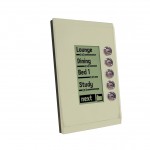


Introduction
C-Bus is a microprocessor-based control & management system for Buildings & Homes. It is used to control lighting & other electrical services such as pumps, Audio Visual Devices, Motors, etc. Whether simple ON/OFF control of a lighting circuit, or variable (analogue) type control, such as electronic dimmable fluorescent ballasts, C-Bus can be used to easily control virtually any type of electrical load.
To ensure fast & reliable operation, each C-Bus device has its own in-built microprocessor & “intelligence”, allowing units to be individually programmed.
C-Bus uses a patented method for updating the status of units. This method does not require a central computer or central controller to handle databases or lookup tables to operate. The status of each C-Bus unit is initiated at specific time intervals, without the need of a central controller. Each device is allocated a specific time frame to broadcast its status, synchronised by a self-generated system clock pulse. This allows large amounts of data to be transmitted in a very small time frame, effectively & reliably on the network, leading to low processing overheads & low bandwidth requirements.
Why C-Bus?
The primary reasons to use C-Bus are:
- Highly robust & reliable control system, but low cost per node.
- Wide range of tools available to allow 3rd party companies to interface to both PC based & embedded systems.
- A single C-Bus cable connection can control an unlimited number of devices.
- Ultimate flexibility in switching & control – functions can be changed, added, removed, moved, reprogrammed, at any position on the network, at any time – without any cumbersome hard-wiring.
- C-Bus is simple to install & commission.
- C-Bus can control any type of load, digital & analogue.
How C-Bus Works
C-Bus Network Wiring
The C-Bus Network Bus is the communications wiring for the system, consisting of an unshielded twisted pair (UTP) ‘Cat 5’ cable. The Bus not only provides the means of communication between units, but also the small amount of power needed to operate the circuitry within each C-Bus unit.
The C-Bus Network is electrically isolated from the mains power, & operates at safe extra low voltage levels (36 V dc). Legal restrictions of mains wiring do not apply, so C-Bus wiring may be run into places that would be dangerous (or illegal) with normal mains wiring.
All Input & Output devices are wired to any point in the C-Bus Network by a twisted pair cable, which carries all communications between the Units.
The C-Bus connections may be looped from unit to unit or a branch can be made at any point. This ‘free topology’ structure provides a flexible system layout. New units can be added anywhere, at any time, without re-configuration.
During commissioning, the system is programmed so that specific commands trigger specific responses in one (or more) devices on the Network. At any time the commands can be re-programmed, & C-Bus units can also be added, removed or moved.
The size of a C-Bus Network is practically unlimited. A large network is usually divided into sub-networks of 100 C-Bus Units, with a total cable length of 1000m per sub-network. This allows a C-Bus system to be divided into manageable sections, simplifying design, limiting potential fault propagation & aiding in any troubleshooting.
C-Bus Units
All Units on the C-Bus Network have their own built-in microprocessor, allowing them to operate independently with “distributed intelligence”. This provides extremely reliable & efficient communications, & also means that a malfunction in one unit will not affect the operation of any other Unit or the Network.
Every C-Bus Unit has a unique number, so that all devices on the Network can communicate directly. Also, as C-Bus uses point to multi-point communication, every device on a C-Bus Network issues & responds to commands directly from the Network, rather than requiring a central computer or controller.
Simple Control
Each C-Bus device is programmed to issue & respond to the certain commands. A virtually unlimited number of commands can be programmed into the C-Bus system. Generally, Input Devices are programmed to issue commands, & Output Devices are programmed to execute those commands.
When a C-Bus Group Address comm& is issued by a C-Bus Device, any other Devices that have been programmed with that Group Address will be activated, wherever they are on the C-Bus Network. There is no need for any direct 240V connection between any C-Bus units.
Multiple Events
Single Devices can also produce multiple events. For example, you may program an Input Switch so that the length of time the key is pressed determines what Command is issued – a short press issues an on/off command & a long press controls a dimming command.
Multiple commands do not have to control the same Output Device(s), so complex scenarios can be easily created, for example a single push button switch controlling a whole floor of a building.
Multiple Input devices can conditionally control a single Output Device, dependant on specific circumstances. This allows multiple levels of over-ride switching & other complex control systems to be created easily.
Control Flexibility
The C-Bus system can carry out control in virtually unlimited ways, including:
- Any input device can be programmed as a master control point. Master overrides can be positioned anywhere in the network, & control any other unit or units on any connected network.
- The system can allow unlimited switching configurations. Two, three (or any number) of switches can be set to toggle or control any other switch or device.
- Overrides can be easily re-programmed via Windows software at any time.
- A computer or cental controller is not required for normal C-Bus operation, but can be used to add additional features if desired.
For acknowledgement of this information and for more information, please contact the Clipsal website at www.clipsal.com.au
